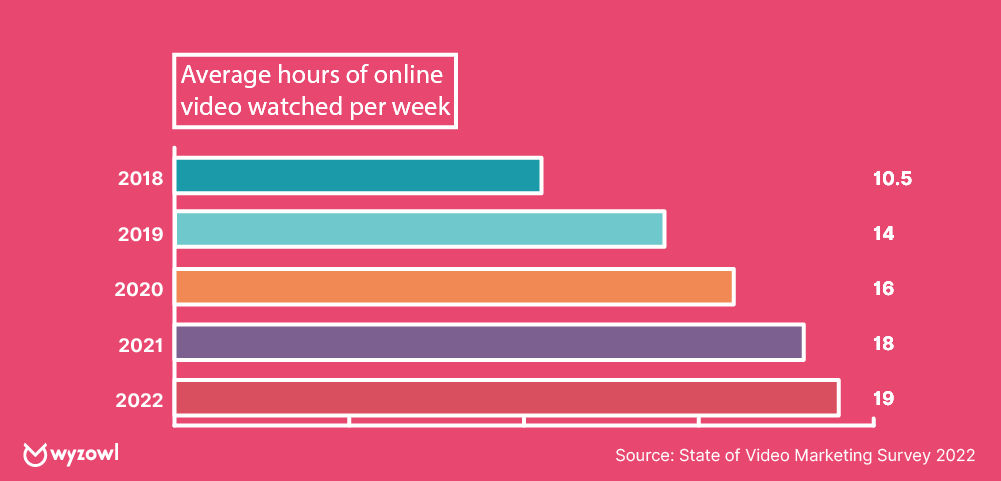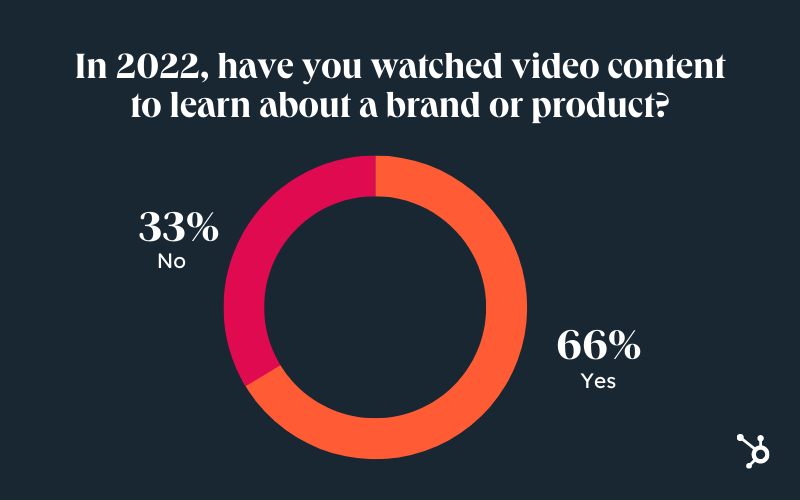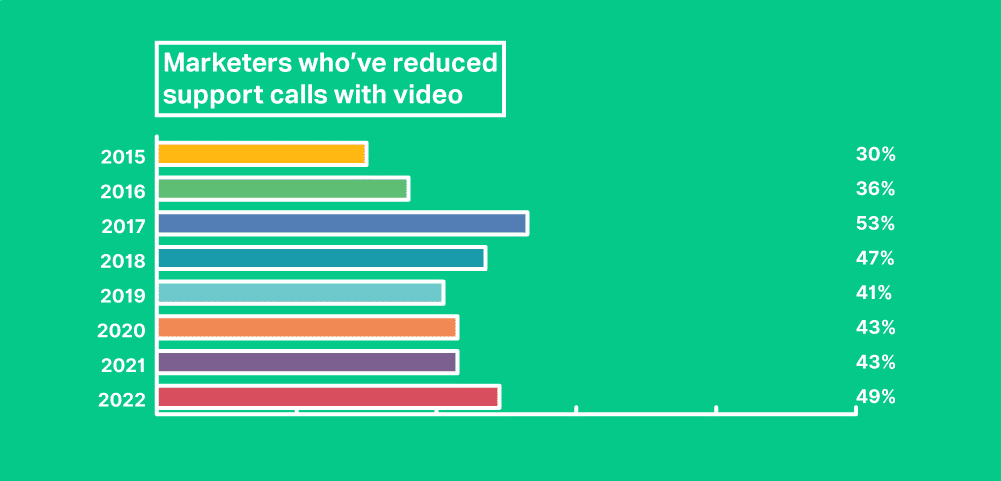What if I told you that in the past decade a fundamental shift had occurred in the way that people communicate with each other and interact with businesses?
What if I also told you that most businesses haven’t remotely caught up with this and are completely missing the boat?
The boat that they’re missing is called “video marketing” and it can help your company connect with prospects and customers like never before.
The Video Revolution
Once upon a time, the only place that you would go to see a video would be at a movie theater or on TV or a VCR. You’d go to Blockbuster to rent a videotape or Redbox to rent a DVD.
You could theoretically download a video online but dial-up internet was super slow. Even a short low-resolution tutorial would take forever.
But within the past few decades, advances in technology have allowed videos to be streamed without overburdening a data plan. So now, anyone anywhere can watch videos on their cell phone. There’s no technological constraint anymore. As a result, video has exploded everywhere.
In fact, online video consumption has nearly doubled in the last four years alone.

(Source: Wyzow “The State of Video Marketing 2022”)
Whether we’re FaceTiming someone, attending a Zoom meeting or watching YouTube, video is now a primary method of communication in our daily lives. And while your business may or may not be using video marketing on a regular basis, you undoubtedly are using it in your own life.
We’ve shifted as a culture. The video revolution has happened—and it’s time to catch up.
What Is Video Marketing?
Video marketing is simply using video in any capacity to convey marketing messages, as opposed to written words, audio or pictures. This can be anything from YouTube videos or TikToks to webinars and livestreams. Even “explainer” videos and tutorials fit into the category of video marketing.
Why Use Video Marketing?
Video has not only exploded over the past five years, it’s become an everyday means of communication in our business operations as well as our personal lives.
Businesses that are on board instantly have an edge over their competitors. Those that are catching the wave are evolving with the times. And those that don’t are drifting further and further out to sea.
Here’s how you can up your game with video marketing:
1. Drive more traffic to your website
Seventy-eight percent of users got more traffic to their websites by using video, according to a survey by Renderforrest, a branding platform provider. Of course, this doesn’t mean that simply adding a single video to your site will bring you a deluge of site visitors. But it does mean a site making strategic use of videos will enjoy more traffic than one that doesn’t.
2. Engage more prospects
While some users may still plow through website pages that describe a company’s offerings, two-thirds turn to video to learn more about a brand or product. Clearly, video has graduated from pet tricks—still a very popular topic—to mainstream business. Adding video to your marketing mix will draw more online attention and prospects to your brand.

(Source: HubSpot)
3. Make more sales
Ninety-three percent of businesses acquire a new customer after sharing a video on social media, per a study by Animoto, a video production company. That means video marketing not only boosts your website traffic but your brand’s social media presence as well—netting you more exposure and customers.
4. Get more bang for your buck
Investing more dollars into video marketing will bring more dollars back to your business. Ninety-two percent of marketers found video returned good ROI according to a study by Wyzow, a video production company. But it takes more than posting a video to your site or Facebook profile to see a good return; it requires video plus the use of relevant keywords, engaging headlines and descriptions, hashtags and strategic distribution of the content on the right channels.
5. Save support and customer service costs
Creating “explainer videos” and other instructional videos will reduce time and resources for your customer service and support personnel.

(Source: Wyzow “The State of Video Marketing 2022”)
Apple, for instance, has an “Apple Support Channel” on YouTube with myriad instructional videos such as “How to Use Apple Pay” or “10 Helpful iPhone Tips.” Rather than contacting Apple for help, users can watch instructional videos instead. This saves Apple from having to provide additional support or customer service personnel. Worst case, it frees up these employees to tend to more pressing issues.
Why Video Marketing Works
In today’s world, people don’t want sterile corporations. Everyone’s trying to create a more personal, more connected and more approachable relationship with their customers. Even if the videos aren’t made by the owner, you want your audience to come away with a warm and fuzzy feeling about your company. And the best way to achieve that is video.
With video, customers can see your face. They can hear the inflection in your voice and see your expression. It leaves them feeling like they had a conversation with you. Clients feel like they know you or your key staff rather than a faceless, nameless organization.
Done right, video marketing:
- Increases interest in your brand and the time spent learning about it
- Enhances understanding of your products and services
- Fosters trust by creating a sense of physical existence
- Connects you directly and intimately with your audience
- Inspires social media engagement and word of mouth
Types of Video Marketing
Video marketing can seem complicated, so let’s first look at the common types of videos used:
Welcome videos
With a “welcome video” on your website’s home page, you can instantly introduce site visitors to your company, its products and services and their benefits. It’s a highly effective and more intimate way to familiarize prospects with your company. In our own Uplift Marketing welcome video, we illustrate how we help businesses grow with digital marketing and services we provide:
Welcome videos can also be used in social media posts, marketing emails to sales funnel prospects and much more.
Brand story videos
Just as the name implies, a brand story video is a narrative that conveys the essence of your brand. It would include a bit of your brand’s story, its core values and what it stands for. If you have a brick-and-mortar business, it could also include workplace shots of employees in action to convey your company’s culture.
A textbook example is from HubSpot, a marketing and sales software provider. Their video takes a billion-dollar public company and humanizes it. It begins with the company’s CEO and co-founder explaining how he started the company, its mission and the values he’s instilled in it—all in an earnest and unassuming way. In other words, it’s authentic. The video is interspersed with images of Hubspot’s impressive facilities with the staff in action. In just two minutes, HubSpot takes you from knowing little about the company to feeling like you’re now friends with the CEO. That’s the power of the brand story video. Done well, it hits home more rapidly and forcefully than any written content could.
In a brand story video we created for Advanced Chiropractic Services, a Midwest chiropractic practice, we wanted the owner to share his heartfelt purpose to help others which motivated him to open his own practice. The video includes glowing testimonials from patients and staff alike along with shots of staff treating patients. All in all, the video serves to provide viewers with this takeaway: Advanced Chiropractic is a caring practice with the know-how to return people to healthier, happier lives.
Explainer marketing videos
Animated explainer videos are an easy, engaging way to explain your products or services and convey complex ideas that might otherwise be lost on your site visitors. A classic example is this video from PayPal which describes how their money transfer services work and how to get started:
Testimonial videos
Having your customers extol the virtues and benefits of your services or products inspires confidence and trust in potential buyers. A powerful testimonial video from management consulting group Peds-A-Palooza, a client (and dear friends of ours), enables viewers to discover in a one-on-one intimate setting how the firm has helped clients have better practices and thus better lives.
Tutorials and customer service videos
There’s nothing like being able to refer a customer to a video which exactly answers their question. Whether they are professionally scripted or informal screenshares, tutorials can help answer common questions and make your customer service process much smoother. Dropbox does this by showing users how to easily save and access documents across an array of devices:
Video blogs or vlogs
These informal videos are used to connect with your audience on a personal level, provide value and share knowledge—thus helping elevate your status as a thought leader in your industry. A vlog we created for an Uplift client features one of their lead therapists educating readers on key knowledge that they need to improve their lives.
You may already know that vlogging has become an industry in and of itself. Professional vloggers build their own brands by producing videos of themselves in all sorts of situations. For example, Casey Neistat is a “YouTuber”—a vlogger with lots of personality and twelve-and-a-half million subscribers—who shoots videos of wild or even mundane events in his daily life. He monetizes his channel through ad revenue.
How do you use this in business, though?
Businesses can create informal videos to educate and provide value to their target audience. These could be posted on their website, their YouTube channel and distributed via email and social media. This establishes a brand as a thought leader with its audience, generates interest from new prospects, improves SEO, deepens the relationship with existing clients, fosters retention and encourages referrals.
Livestreaming
This involves live events streamed on video in real time. Whether Facebook Live, webinars or conferences, livestreaming enables you to engage interactively with your audience and answer questions. Everyone is familiar with Zoom these days, so you might as well use it to connect with your customers.
Tips for Getting Started with Video Marketing
There is no one-size-fits-all approach to video marketing. What works well for someone else might not be great for you. However, here are a few tips anyone can apply:
1. Try video blogging
Considering 25 percent of all online users watch video blogs weekly, it’s worth a small investment of time and resources to start video blogging.
Here’s what works for us. Start with an educational topic that educates customers and helps them solve their problems. Then draft some key talking points (not a script) on that topic and become familiar with them. Next, sit down and shoot a three- to five-minute video that covers those points. Edit it so that it’s smooth, post it on YouTube and then embed the video in a blog post on your website.
We do this all the time. When clients ask us to produce their video blogs, we have a process that takes all the heavy lifting off the business owners—they just shoot the video itself and we do the rest. We even help them come up with ideas and write their talking points!
2. Distribute video as broadly as you can
Incorporate video into your digital advertising and email marketing. When you want to send out a message to your clients, shoot a quick video, upload it to YouTube and then send it out in an email or use it in an ad. This is a powerful way to directly connect with people and get your message out into the world. As an example, below is an excerpt from a client’s company email newsletter:
3. Ask customers for DIY testimonials
Consider getting customer testimonials which can be included on your website and social media. When you have a win with a client, ask them to explain it to you over a recorded Zoom session, or simply do a selfie video while they talk about their experience. This can be edited down into something extremely powerful and authentic when used properly in marketing.
4. Host a webinar or live conference
If you’re a good public speaker, consider hosting a webinar or live conference of some kind. These can be promoted with digital ads or just via your mailing list. This is especially helpful if you’ve got clients across the country instead of a single geographic region. By having regular live video events, you can develop an intimate connection to your clients that otherwise wouldn’t be possible.
5. Hire a professional videographer
If you have the budget, consider professional videography to elevate your brand image. This involves sending out a professional camera crew to shoot brand story videos and product/service videos like the one we made for Rebound Physical Therapy. In the end, you will have epic videos which can be incorporated into your website, social media profiles and other platforms to generate a world-class first impression.
Simple Steps to Shoot a Video
Videography can get pretty fancy with expensive digital cameras and sophisticated lighting systems. We can see very different levels of quality out on the web. This can make a person feel like they can’t get started unless they can invest in super high-end gear and become a video pro.
The good news is you won’t need any of that to make a simple video that is perfectly acceptable for most business uses. The key is to keep it simple—there’s no need to feel intimidated. All you need is a topic, a few talking points and a modern smartphone. You could even use Zoom to record yourself.
Here are a few steps to create a simple video for your audience or customer base:
- Light from the front: Always have your light source in front of you. If you are backlit, your face will be darkened with shadows. You could shoot facing a window for natural light in daytime.
- Keep your distance from the background: If you’re shooting against a wall or other structure, don’t stand too close to it—stay a few feet away so that you’re in focus while the background is somewhat blurred.
- Use a tripod: Smartphone tripods are widely available online. Get one to shoot your video to prevent camera shake. Otherwise, your clip will look like it was shot during an earthquake.
- Check your focus: Make sure you’re clearly in focus. It’s good to have a blurry background, but not your face.
- Do a test run: The good thing about DIY video is you can take as many trial shots as you like until you’re satisfied everything looks good.
- Shoot your video: Press “record” and start shooting. Don’t worry about sputters, making mistakes, awkward pauses and so on while shooting; those will be removed in the next step.
- Edit to a polished presentation: You can either use video editing software yourself or you can hire someone to edit your video. Either way, the goal is to edit out all the “um’s” and “er’s” and other mistakes until you have a smooth, cohesive video.
You may be asking yourself how long your video should be. The answer often depends on the type of video you’re making. If you’re making a quick sales announcement, two to three minutes is good. If you’re doing a full-length video blog, it can be longer.
There’s No Time Like the Present
Video marketing is a great way to build brand trust and loyalty, effectively educate your audience and increase engagement on social and digital channels.
We realize that it can seem complex and difficult at first, especially if you’re a business owner with a million things to do already.
If you need help getting started, feel free to reach out. We regularly produce just about all of the videos mentioned in this article and can make it very easy for you. This includes sending a professional videography team to your site, supervising the shoot and producing a polished ready-to-use video. Our vlogging process is also streamlined so it requires very little of the business owner’s time and attention. Give us a call at (314) 690-1575 or contact us online to find out more.




